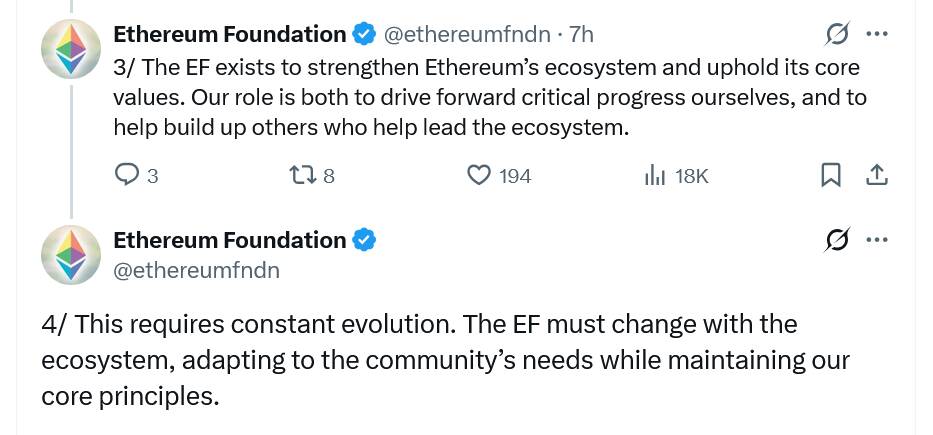The Ethereum Foundation, a key player in the development of the Ethereum blockchain, has recently implemented significant changes to its leadership structure. Through a blog post on April 28, the foundation announced that it aims to strengthen its governance by clearly delineating the roles of its management and board of directors. The new structure will allow the board to serve as a “security council” dedicated to safeguarding the vision and integrity of the Ethereum ecosystem.
As part of this revamped leadership, Hsiao-Wei Wang and Tomasz K. Stańczak have been appointed as co-executive directors, effective from April 28. Their tenure emphasizes crucial goals such as promoting censorship resistance, advancing open-source innovation, and enhancing privacy and security within the network. Notably, Stańczak, who also leads Ethereum infrastructure firm Nethermind, has a two-year mission to tackle some of the pressing challenges facing Ethereum.
“The foundation has adopted a more active role in the Ethereum ecosystem in recent months,” the Foundation stated, responding to criticism about its previous engagement levels.
Additions to the management team include Bastian Aue, focusing on organizational strategy, and Josh Stark, whose responsibilities encompass project execution, communications, and marketing. The board membership features prominent figures like Ethereum co-founder Vitalik Buterin and the foundation’s President Aya Miyaguchi, who will guide strategic direction and manage essential external relationships.
This shift in governance comes amid ongoing discussions within the Ethereum community regarding the foundation’s engagement in decentralized finance (DeFi) innovation. Critics, including Synthetix founder Kain Warwick, have highlighted a perception that the foundation was not responsive enough to the evolving DeFi landscape. Concurrently, some community members have linked the foundation’s previous inaction to the underperformance of Ether (ETH) compared to other cryptocurrencies.
Looking ahead, the Ethereum Foundation has outlined its main focus areas for the next year, which include scaling Ethereum’s base layer, enhancing layer 2 solutions, and improving overall user experience. Researchers within the foundation have already proposed measures—under Ethereum Improvement Proposals (EIPs)—to increase the gas limit, aiming to boost transaction capacity significantly, which is essential for Ethereum’s competitive edge.
This comprehensive restructuring signifies a pivotal moment for the Ethereum Foundation as it seeks to bolster its impact on the ever-evolving blockchain landscape.
The Ethereum Foundation’s New Leadership Structure
The Ethereum Foundation has implemented a significant change in its leadership approach, impacting how it supports and develops the Ethereum blockchain. Here are the key points related to this overhaul:
- Separation of Responsibilities:
- The management team and board of directors have distinct roles.
- The board acts as a “security council” focused on safeguarding the foundation’s core values and setting visions for Ethereum.
- The management is dedicated to strategic and operational execution of those visions.
- New Co-Executive Directors:
- Hsiao-Wei Wang and Tomasz K. Stańczak appointed as co-executive directors.
- Their focus includes championing censorship resistance, open-source innovation, and enhancing privacy and security.
- Stańczak has a two-year term to tackle key challenges while balancing his role at Nethermind and a new venture capital firm.
- Expanded Management Team:
- Bastian Aue will concentrate on organizational strategy and training.
- Josh Stark will handle project execution, communications, and marketing.
- Board Composition:
- Includes notable figures such as Vitalik Buterin and Aya Miyaguchi.
- Vitalik provides technical guidance, while Miyaguchi oversees the vision and external relationships.
- Patrick Storchenegger is responsible for legal and compliance matters.
- Responses to Criticism:
- The Foundation has taken a more proactive role in the Ethereum ecosystem following criticism about its engagement in decentralized finance.
- This response could influence how developers and investors view the Ethereum ecosystem, potentially affecting the demand for ETH.
- Focus on Scaling:
- The Foundation aims to scale both layer 1 and layer 2 solutions and improve user experience within the next year.
- Proposals for increasing Ethereum’s gas limit could enhance transaction throughput substantially.
- Efficient scaling may positively impact how users and developers interact with the Ethereum network.
“The Ethereum Foundation’s restructuring reflects a commitment to prioritize key developmental challenges within the Ethereum ecosystem, a move that could influence the entire blockchain community.”
Ethereum Foundation Revamps Leadership: Key Impacts on the Ecosystem
The Ethereum Foundation’s recent restructuring marks a significant shift in its approach to governance and development, promoting a more distinct separation between its management and board of directors. This change comes on the heels of criticism regarding the Foundation’s engagement with decentralized finance and the development community. With notable appointments like Hsiao-Wei Wang and Tomasz K. Stańczak stepping into executive roles, the Foundation aims to bolster its presence in Ethereum’s evolving landscape.
Competitive Advantages: The newly established governance framework may lead to clearer strategic execution, allowing the foundation to effectively champion key issues such as censorship resistance and user privacy. By separating oversight from operational roles, the Foundation can ensure that its vision is not only aspirational but also actionable. With leaders from various sectors, including co-founder Vitalik Buterin, this structure fosters a diversity of thought, which may attract developers and investors who seek a coherent roadmap.
Potential Disadvantages: However, the shift may come with drawbacks. The unconventional nature of the board’s authority to appoint and dismiss executive directors can create instability. Frequent changes in leadership might deter established developers from committing to long-term projects, fearing shifting priorities. Furthermore, some within the community may continue to question the Foundation’s motives, especially given the perception that it has historically lagged in proactive engagement.
The restructuring could particularly benefit developers and projects focused on innovative solutions within the Ethereum ecosystem. They now have an organized channel to push for scalability and enhance user experience—key areas the Foundation has recognized as priorities. On the flip side, this transition could pose challenges for individual community members who may feel sidelined or outpaced by the Foundation’s increasing agenda, particularly those from smaller projects that can’t compete for attention on such a larger stage.
In summary, the Ethereum Foundation’s overhaul could herald a more effective governance model, but it may also require careful navigation to maintain community trust and engagement. As Ethereum continues to compete with other blockchains like Bitcoin and Solana, these dynamics will be critical in determining the ecosystem’s direction.

















